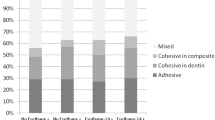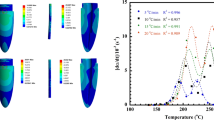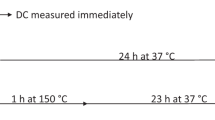Abstract
In order to reduce shrinkage and improve the mechanical properties of dental composite resins, we designed a hybrid resin formulation containing a novel matrix resin, BisS-GMA [bisphenol-Sbis( 3-methacrylato-2-hydroxypropyl)ether], and epoxy modified by a spiro-orthocarbonate (SOC) expanding monomer. Then, we tested the effects of an iodonium salt, diphenyliodonium hexafluorphosphate (DPIHFP), on the properties of the hybrid resin with seven different concentrations. The hybrid resin was polymerized by a ternary photo-initiator system. The volumetric shrinkage (VS), degree of conversion (DC) and compressive strength (CS) were assessed using AcuVol™, FTIR and a universal testing machine, respectively. The VS, DC and CS were improved with increasing DPIHFP concentration, but a high concentration of DPIHFP had a negative influence on the mechanical properties of the hybrid resin and offered no added improvement in the VS and DC. The best performance of a composite resin containing BisS-GMA and SOC-modified epoxy was achieved with 2wt% DPIHFP. The results also indicated that the resin containing BisS-GMA was superior to that containing Bis-GMA in terms of VS, DC and CS.
Similar content being viewed by others
References
Min SH, Ferracane J, Lee IB. Effect Of Shrinkage Strain, Modulus, And Instrument Compliance On Polymerization Shrinkage Stress Of Light-Cured Composites During The Initial Curing Stage[J]. Dental Materials, 2010, 26(10): 1024–1033
Watts DC, Marouf AS, Al-Hindi AM. Photo-Polymerization Shrinkage-Stress Kinetics In Resin-Composites: Methods Development[J]. Dental Materials, 2003, 19(1): 1–11
Cramer NB, Stansbury JW, Bowman CN. Recent Advances And Developments In Composite Dental Restorative aterials[J]. Journal Of Dental Research, 2011, 90(4): 402–416
Kusgöz A, Tüzüner T, Ülker M, et al. Conversion Degree, Microhardness, Microleakage and Fluoride Release of Different Fissure Sealants[J]. Journal of The Mechanical Behavior of Biomedical Materials, 2010, 3(8): 594–599
Marchesi G, Breschi L, Antoniolli F, et al. Contraction Stress of Low-Shrinkage Composite Materials Assessed with Different Testing Systems[J]. Dental Materials, 2010, 26(10):946–953
Kim Y, Kim CK, Cho BH, et al. A New Resin Matrix for Dental Composite Having Low Volumetric Shrinkage[J]. Journal of Biomedical Materials Research Part B: Applied Biomaterials, 2004, 70(1): 82–90
Kim JW, Kim LU, Kim CK, et al. Characteristics of Novel Dental Composites Containing 2, 2-Bis[4-(2-Methoxy-3-Methacryloyloxypropoxy)Phenyl] Propane as A Base Resin[J]. Biomacromolecules 2006, 7(1): 154–160
Lee TY, Carioscia J, Smith Z, et al. Thiol-Allyl Ether-Methacrylate Ternary Systems. Evolution Mechanism of Polymerization-Induced Shrinkage Stress and Mechanical Properties[J]. Macromolecules, 2007, 40(5): 1473–1479
Liu WW, Chen S, Liu YR, et al. Synthesis of A Liquid-Crystalline Resin Monomer with the Property of Low Shrinkage Polymerization[J]. Dental Materials, 2013,32(4): 550–556
Lu H, Carioscia JA, Stansbury JW, et al. Investigations of Step-Growth Thiol-Ene Polymerizations for Novel Dental Restoratives[J]. Dental Materials, 2005, 21(12):1129
Fu J, Jia F, Xu H, et al. Properties of A New Dental Photocurable Matrix Resin with Low Shrinkage[J]. Journal of Wuhan University of Technology-Materials Science Edition, 2011, 26(2): 236–241
He PS, Zhou ZQ, Pan CY, et al. An Epoxy Resin Copolymer with Zero Shrinkage[J]. Journal Of Materials Science, 1989, 24(5): 1528–1532
Eick JD, Byerley TJ, Chappell RP, et al. Properties of Expanding SOC/Epoxy Copolymers for Dental Use in Dental Composites[J]. Dental Materials, 1993, 9(2):123–127
Kostoryz EL, Tong PY, Chappelow CC, et al. In Vitro Cytotoxicity of Solid Epoxy-Based Dental Resins and Their Components[J]. Dental Materials, 1999, 15(5): 363–373
Ogliari FA, Ely C, Petzhold CL, et al. Onium Salt Improves the Polymerization Kinetics in an Experimental Dental Adhesive Resin[J]. Journal Of Dentistry, 2007, 35(7): 583–587
Sun X, Li YC. Shrinkage Properties of a Modified Dental Resin Composites Containing a Novel Spiro-Orthocarbonate Expanding Monomer[J]. Materials Letter, 2011, 65(23–24): 3586–3589
Gonçalves LS, Moraes RR, Ogliari FA, et al. Improved Polymerization Efficiency of Methacrylate-Based Cements Containing an Iodonium Salt[J]. Dental Materials, 2013, 29(12): 1251–1255
Fumio S, Toshikazu T, Takeshi E. Radical Polymerization of 3,9-Dimethylene-1,5,7,1l-Tetraoxaspiro[5.5]Undecane. Study of the Structure of The Polymer And Mechanism of Polymerization[J]. Macromolecules, 1993, 26(4): 729–736
Tiba A, Charlton DG, Vandewalle KS, et al. Comparison of Two Video-Imaging Instruments for Measuring Volumetric Shrinkage of Dental Resin Composites[J]. Journal Of Dentistry, 2005, 33(9): 757–763
Sharp LJ, Choi IB, Lee TE, et al. Volumetric Shrinkage of Composites Using Video-Imaging[J]. Journal Of Dentistry, 2003, 31(2): 97–103
Komori PCP, Paula AB, Martin AA, et al. Effect of Light Energy Density on Conversion Degree and Hardness of Dual-Cured Resin Cement[J]. Operative Dentistry, 2010,35(1): 120–124
Sunitha C, Kailasam V, Padmanabhan S, et al. Bisphenol a Release from an Orthodontic Adhesive and its Correlation with the Degree of Conversion on Varying Light-Curing Tip Distances[J]. American Journal Of Orthodontics And Dentofacial Orthopedics, 2011, 140 (2): 239–244
Gao BT, Lin H, Han JM, et al. Polymerization Characteristics, Flexural Modulus and Microleakage Evaluation of Silorane-Based and Methacrylate-Based Composites[J]. American Journal Of Dentistry, 2011, 24(2): 97–102
BS2938:1985, British Standards Institution Specification for Dental Amalgam Alloy[S].
Baroudi, K, Saleh, AM, Silikas, N, et al. Shrinkage Behaviour of Flowable Resin-Composites Related to Conversion and Filler-Fraction[J]. Journal Of Dentistry, 2007, 35(8): 651–655
Nenajdenko V, Gavryushin A, Balenkova E. A Facile Route to Thiophene-1,1-Dioxides Bearing Electron-Withdrawing Groups[J]. Tetrahedron Letters, 2001, 42(26): 4397–4399
Podsiadly R, Maruszewska A, Michalski R, et al. Naphthoylene benzimidazolone Dyes as Electron Transfer Photosensitizers for Iodonium Salt Induced Cationic Photopolymerizations[J]. Dyes Pigments, 2012, 95(2):252–259
Wang Y, Spencer P, Yao X, et al. Effect of Coinitiator and Water on the Photoreactivity and Photopolymerization of HEMA/Camphoquinone-Based Reactant Mixtures[J]. Journal Of Biomedical Materials Research Part A, 2006, 78(4):721–728
Kim D, Scranton A. The Role of Diphenyl Iodonium Salt (DPI) in Three-Component Photoinitiator Systems Containing Methylene Blue (MB) and an Electron Donor[J]. Journal Of Polymer Science Part A-Polymer Chemistry, 2004, 42(23): 5863–5871
Gömeç Y, Dörter C, Dabanoglu A, et al. Effect of Resin-Based Material Combination on the Compressive and the Flexural Strength[J]. Journal Of Oral Rehabilitation, 2005,32(2):122–127
Della BÁ, Benetti P, Borba M, et al. Flexural and Diametral Tensile Strength of Composite Resins[J]. Brazilian Oral Research, 2008,22(1):84–89
Durner J, Obermaier J, Draenert M, et al. Correlation of the Degree of Conversion with the Amount of Elutable Substances in Nano-Hybrid Dental Composites[J]. Dental Materials, 2012,28(22):1146–1135
Rastelli ANS, Jacomassi DP, Bagnato VS. Degree of Conversion and Temperature Increase of a Composite Resin Light Cured with an Argon Laser And Blue LED[J]. Laser Physics, 2008, 18(12):1570–1575
Ferracane JL, Greener EH. The Effect of Resin Formulation on the Degree of Conversion and Mechanical Properties of Dental Restorative resins[J]. Journal Of Biomedical Materials Research Part B: Applied Biomaterials, 1986, 20(1):121
Author information
Authors and Affiliations
Corresponding author
Additional information
Funded by the National Natural Science Foundation of China (No.50673065)
Rights and permissions
About this article
Cite this article
Liu, W., Fu, J., Wu, X. et al. Influences of iodonium salts on the properties of a hybrid composite resin containing BisS-GMA and expanding monomer modified epoxy. J. Wuhan Univ. Technol.-Mat. Sci. Edit. 30, 1184–1190 (2015). https://doi.org/10.1007/s11595-015-1293-4
Received:
Accepted:
Published:
Issue Date:
DOI: https://doi.org/10.1007/s11595-015-1293-4




